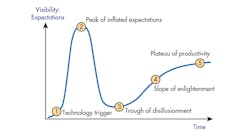Download this article as a .PDF
RF microelectromechanical-systems (MEMS) technology has been in use for about two decades, although from a market perspective, the disappointments seem to outweigh the successes. Full deployment of the technology is yet to come, however, and 5G mobile communications standards may be fertile ground to exploit the full potential of MEMS technology.
For more than 20 years, research articles have touted the capabilities of RF-MEMS passive components, such as micro relays and variable capacitors (varactors). These components have been lauded for their low loss, high isolation, and wideband performance. In addition, their use in higher-level assemblies, such as multiple-state impedance tuners and programmable phase shifters, pointed to broad mass-market adoption of MEMS devices and components.
Early predictions forecast widespread MEMS adoption.1 Bearing in mind the classic transceiver (transmitter/receiver) architecture of mobile telephone handsets, the deployment of RF-MEMS was seen to follow two phases. In the first phase, MEMS passive components, such as antenna switches and RF/IF filters, would replace their counterparts based on conventional (discrete component or MIC) technologies.
The development of more integrated MEMS devices—such as multiple-channel selectors with embedded filtering functions, as well as hybrid mixer/filters—would lead to the second phase, and to a rethinking of the transceiver architecture in terms of MEMS technology. The RF transceiver block diagram would be simplified, with fewer LNAs and increased coverage of services and frequency bands.
The actual evolution of MEMS technology was much different. From 2002 to 2003 and for about one full decade through about 2013, market forecasts predicted a massive penetration of RF-MEMS technology into consumer markets for mobile phones.2 But market estimates of hundreds of millions of U.S. dollars were systematically downsized with each market analysis, and the integration of the cellular transceiver and expected market consolidation never occurred.
Such fluctuating market behavior can be explained by an empirical graphic tool, known as a hype curve.3 When a novel technology emerges, expectations of its market impact grow quickly (Fig. 1). As soon as possible exploitations are analyzed into details, the initial enthusiasm drops quite steeply to a minimum. This takes place for various reasons, including lack of maturity of the technology, integration/qualification issues, and costs.
This drop in expectations is also a trigger that focuses attention towards any weaknesses in the technology and its applications. This leads to the final part of the hype curve cycle, which is the consolidation of a certain technology in one or more market applications and segments.
Fitting the evolution of RF-MEMS technology into the boundaries of a classical hype curve cycle does not seem a simple task. Staring at one decade of market studies, forecasts, and rumors, it’s as if the hype curve of MEMS-based RF passive components underwent two subsequent peaks of inflated expectations—and, consequently, two harsh drops.2
The first deflation, which occurred around 2003 to 2004, was mainly driven by technology intrinsic factors. In particular, reliability (including medium- and long-term mechanical and electrical reliability), packaging, and integration with standard technologies, were the main factors impairing the employment of MEMS devices into commercial market. Moving forward from that time, research efforts targeted those problem areas, leading to significant improvements. From then on, the evolution of RF-MEMS technology has followed the standard pattern of hype curve cycles.
Improvements in reliability, packaging, and integration level triggered a second peak of inflated expectations around 2009 to 2010, followed by another steep fall afterwards. The motivation of such a singular behavior can be attributed to extrinsic factors linked to the surrounding market environment, rather than to RF-MEMS technology itself. In fact, mobile communications through 3G and 3.5G were not really in need of components with the enhanced characteristics of MEMS-based RF passives components. The exploitation of RF-MEMS technology has always been more oriented to a technology push rather than a market pull philosophy.2
With 4G-LTE mobile communications mobile devices—and their use of touchscreens, integration of antennas inside the handset, and increased difficulty of including ad hoc performance-boosting circuitry—a trend of degradation in the quality of communications began.4 It was estimated that the ratio of theoretical versus actual RF signal quality was decreasing with a pace of about 1 dB/year for over a decade.
Because of the aforementioned factors, smartphone antennas were not working under optimal conditions, leading to slower download speeds, reduced quality of voice service, lower energy efficiency, and more dropped calls. Therefore, fixed impedance matching between the transmitting/receiving antenna and the RF front end (RFFE) adopted in previous mobile handsets generations was no longer the best option.
This change in mobile communications scenario boosted demand for reconfigurability and tunability of passive components, which RF-MEMS technology has always been capable of addressing. In 2012, information emerged about RF-MEMS-based adaptable impedance tuners (from WiSpry) in Samsung Focus Flash Windows smartphones.5 In Fall 2014, Cavendish Kinetics (CK) announced commercial adoption of its RF-MEMS-based antenna tuning solution in the Nubia Z7 smartphone, manufactured by the Chinese ZTE Corp.6
In early 2017, CK went public with the adoption of its RF-MEMS solutions by more than 40 LTE smartphones, including the Samsung Galaxy A8.6 Other important players, such as Qorvo, extended the functionality of commercial RFFEs by adopting RF-MEMS switching units.7
It seems that RF-MEMS technology, after a nearly 20-year period of inflated expectations and harsh disappointments, is making its way along the hype curve toward the so-called plateau of productivity (Fig. 1). However, this is not a time of final accomplishments for RF-MEMS technology but the beginning of something new.
Opportunities lie ahead for RF-MEMS in the devices and infrastructure of 5G mobile communications systems. Although the transition from 4G-LTE to 5G should be smooth, 5G will represent a total different paradigm, not just with its use of millimeter-wave frequencies but with machine-to-machine (M2M) functionality8 and the enormous amount of IoT data it will handle.
Predictions call for 5G data capacity as much as 1,000 times that of 4G-LTE, delivering 10 Gb/s to each user. In support of M2M and vehicle-to-vehicle (V2V) applications, 5G latency must be low (on the order of milliseconds). In addition, more symmetry between downlink and uplink data transmission capacity will be needed for a 5G standard that can handle M2M applications.
Radio access technologies (RATs) for 5G must address three areas to increase the amount of transmitted data9:
- Modulation order
- Aggregated bandwidth
- Order of multiple-input, multiple-output (MIMO) antennas
If enhancing the first degree of freedom (DoF) is a challenge to be met mainly at algorithm and electronic design levels, then addressing the second and third items will require flexibility in hardware reconfigurability. In particular, improving the aggregated bandwidth means increasing the number of carrier aggregation (CA) components. In terms of hardware specifications, RF transceivers will need to quickly change frequencies as different bands are available in a 5G wireless system.
Increasing MIMO is a matter of having arrays/matrices of integrated antennas (e.g., 4 × 4) small enough to be employed in smartphones, and driven by high-performance RFFEs with improved switching and filtering characteristics to minimize interferences and crosstalk.
In terms of mobile communications infrastructure, another trend on its way of consolidation is the frequency diversity across the backhaul portion of the network hierarchy. To this regard, a clear frequency divide will characterize 5G networks. The classical macro-cells, covering extended areas, will mainly work in the sub-6 GHz range. On the other hand, the large data throughput required will be enabled via significant network densification.
Small cells will be deployed, covering limited spaces such as a single office building or shopping mall. The use of small cells will enable the use of data transfer via licensed and unlicensed millimeter-wave frequencies, but they will require arrays of reconfigurable antennas and RF drivers capable of advanced beamforming for effective directivity and efficient area coverage.
A wish list for RF passive components based on the expectations of 5G systems and handsets could look like the following:
- Very wideband switches and switching units with high “off” isolation and low through loss, and low adjacent-channel crosstalk from 2 to 3 GHz to 60 to 70 GHz or higher.
- Reconfigurable filters with high stopband rejection and low passband loss.
- Wideband multiple-state impedance tuners.
- Programmable step attenuators with multiple configurations and flat amplitude and phase characteristics from a few GHz to 60 to 70 GHz.
- Wideband analog phase shifters.
- Hybrid devices with a combination of phase shifting and programmable attenuation (the functions of points 4 and 5 combined into a single device).
- Miniature antennas and arrays, possibly integrated monolithically with one or more devices from points 1 through 6.
These passive-component needs can be addressed by MEMS technology. Since this technology is capable of integrating different functionalities, it provides opportunities for hardware reductions. In fact, reconfigurable phase shifters and programmable attenuators could be monolithically integrated with an array of millimeter-wave antennas using MEMS technology.
If RF-MEMS-based products are in the process of being consolidated in 4G-LTE applications, larger market volumes are possible for emerging 5G applications, both for handsets and for infrastructure. At present, few reports address RF-MEMS devices being tested for use in possible 5G requirements10,11 (Fig. 2). However, more information on this topic is forthcoming, in the form of an e-book written by the author and produced by IOP Publishing (ISBN: 978-0-7503-1545-6).
The book will analyze the challenges of RF-MEMS technology for 5G applications, with practical modeling and design examples. Given the struggle of RF MEMS for its first 20 years, the future of the hype curve cycle may look much different with the onset of 5G mobile communications networks.
References
1. C.T.-C. Nguyen, “Transceiver front-end architectures using vibrating micromechanical signal processors,” Topical Meeting on Silicon Monolithic Integrated Circuits in RF Systems, 2001, DOI: 10.1109/SMIC.2001.942335, pp. 23-32.
2. J. Iannacci, “RF-MEMS: an enabling technology for modern wireless systems bearing a market potential still not fully displayed,” Review paper, Springer Microsystem Technologies, Vol. 21, No. 10, ISSN: 0946-7076, pp. 2039-2052, September 2015, DOI: 10.1007/s00542-015-2665-6.
4. Roger Allan, “RF MEMS Switches Are Primed For Mass-Market Applications.”
5. IHS iSuppli, “Teardown Analysis Service Identifies First Use of RF MEMS Part, Set to be Next Big Thing in Cellphone Radios.”
6. Cavendish Kinetics, “News Releases.”
7. J. Morra, “Chip Makers Build Fortunes From RF MEMS.”
8. W. Xiang, K. Zheng, X.S. Shen (Eds.), “5G Mobile Communications,” Springer International Publishing, 2017. DOI: 10.1007/978-3-319-34208-5
9. P. Gammel, D.R. Pehlke, D. Brunel, S.J. Kovacic, K. Walsh, “5G in Perspective: A Pragmatic Guide to What’s Next,” White Paper.
10. J. Iannacci, M. Huhn, C. Tschoban, and H. Potter, “RF-MEMS Technology for 5G: Series and Shunt Attenuator Modules Demonstrated up to 110 GHz,” IEEE Electron Device Letters (EDL), vol. 37, no. 10, pp. 1336-1339, Oct. 2016. DOI: 10.1109/LED.2016.2604426
11. J. Iannacci and C. Tschoban, “RF-MEMS for Future Mobile Applications: Experimental Verification of a Reconfigurable 8-Bit Power Attenuator up to 110 GHz,” Journal of Micromechanics and Microengineering (IOP-JMM), vol. 27, no. 4, pp. 1-11, Apr. 2017. DOI.



